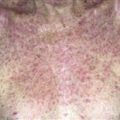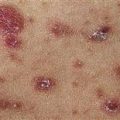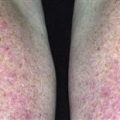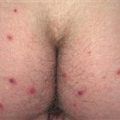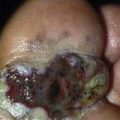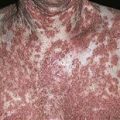63
Herpes simplex (cold
sores, fever blisters)
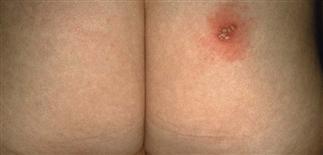
Recurrent herpes simplex. Grouped vesicles have become cloudy on an erythematous base on the buttocks. Herpes on the buttock is seen in a woman.
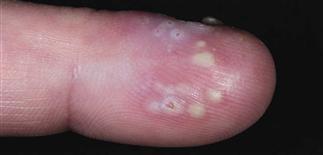
Herpetic whitlow: grouped cloudy vesicles, several with central umbilication. This recurrent eruption is exquisitely tender.
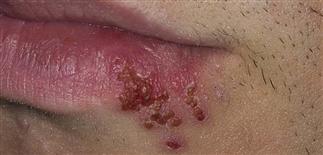
Recurrent herpes simplex. Grouped tiny crusted monomorphic erosions on the lower lip. The lesions have a typical ‘punched-out’ appearance.
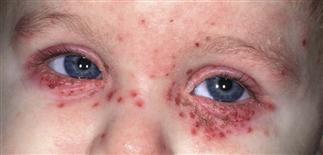
Atopic child with multiple tiny crusted vesicles on lower lids and nose. Herpes simplex occurring in an area of eczema can spread easily and be severe. Oral antiviral treatment is indicated.
DESCRIPTION
DNA virus that causes a vesicular skin infection. Type 1 typically associated with oral infections, type 2 with genital infections. Two infection phases: primary and recurrent.
HISTORY
• Most primary infections asymptomatic. • Virus spread by respiratory droplets, direct lesion contact, or virus-containing fluid shed in people with no evidence of active disease. • Symptoms 3–7 or more days after contact. • Gingivostomatitis and pharyngitis most frequent manifestation. • Prodrome: localized pain, tender lymphadenopathy, headache, generalized aching, fever. • Tenderness, pain, paresthesias, or burning before lesion onset in area of primary infection. • Symptomatic primary genital infection in women may include vulvovaginitis, vaginal and cervical erosions with pain, edema, dysuria. Men or women may also experience proctitis, anorectal pain, discharge, constipation, or tenesmus. • During primary infection, virus ascends through peripheral nerves to dorsal root ganglia, where it becomes latent. • Reactivation spontaneous or by local skin trauma (e.g. ultraviolet light exposure, chapping, abrasion) or systemic changes (e.g. menses, fatigue, fever).
PHYSICAL FINDINGS
• Grouped vesicles on erythematous base appear, subsequently erode. • Primary: vesicles more numerous, scattered; heal without scar. • Diagnosis often clinical; may include culture, Tzanck smear, or rapid direct fluorescent antibody test.
TREATMENT
Prevention of spread: discuss avoidance of sharing glasses, avoid kissing while lesions are open, condoms. Infections resolve without treatment. Therapy based on patient needs. Consider suppressive therapy if frequent and painful recurrences (more than 6 recurrences a year). For pain relief: tetracaine cream 1.8% (Cepacol Viractin cream; over the counter). Sun protection with zinc oxide or sunblock lip balm.
Oral antiviral agents. • Valacyclovir (Valtrex). Initial episode: 1 g b.i.d. for 10 days. Recurrent: 500 mg b.i.d. for 3 days. Recurrent oral-labial infection: 1 g, two tablets b.i.d. for just 1 day. Suppressive: 1 g q.d. If no more than nine recurrences a year, alternative dose 500 mg q.d. • Famciclovir (Famvir). Recurrent: 125 mg b.i.d. for 5 days. Suppressive: 250 mg b.i.d. for up to 1 year. • Acyclovir (Zovirax). Initial episode: 200 mg every 4 h five times a day for 10 days. Suppressive: 400 mg b.i.d. for up to 12 months. Alternative regimens: doses ranging from 200 mg t.i.d. to 200 mg five times a day. Recurrent: 400 mg every 8 h t.i.d. for 5 days.

